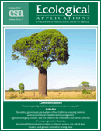Ver ítem
- xmlui.general.dspace_homeCentros Regionales y EEAsCentro Regional Catamarca - La RiojaEEA La RiojaArtículos científicosxmlui.ArtifactBrowser.ItemViewer.trail
- Inicio
- Centros Regionales y EEAs
- Centro Regional Catamarca - La Rioja
- EEA La Rioja
- Artículos científicos
- Ver ítem
Aridity and grazing as convergent selective forces: an experiment with an Arid Chaco bunchgrass
Resumen
It has been proposed that aridity and grazing are convergent selective forces: each one selects for traits conferring resistance to both. However, this conceptual model has not yet been experimentally validated. The aim of this work was to experimentally evaluate the effect of aridity and grazing, as selective forces, on drought and grazing resistance of populations of Trichloris crinita, a native perennial forage grass of the Argentinean Arid Chaco
[ver mas...]
It has been proposed that aridity and grazing are convergent selective forces: each one selects for traits conferring resistance to both. However, this conceptual model has not yet been experimentally validated. The aim of this work was to experimentally evaluate the effect of aridity and grazing, as selective forces, on drought and grazing resistance of populations of Trichloris crinita, a native perennial forage grass of the Argentinean Arid Chaco region. We collected seeds in sites with four different combinations of aridity and grazing history (semiarid/subhumid × heavily grazed/lightly grazed), established them in pots in a common garden, and subjected the resulting plants to different combinations of drought and defoliation. Our results agreed with the convergence model. Aridity has selected T. crinita genotypes that respond better to drought and defoliation in terms of sexual reproduction and leaf growth, and that can evade grazing due to a lower shoot : root ratio and a higher resource allocation to reserves (starch) in stem bases. Similarly, grazing has selected genotypes that respond better to drought and defoliation in terms of sexual reproduction and that can evade grazing due to a lower digestibility of leaf blades. These results allow us to extend concepts of previous models in plant adaptation to herbivory to models on plant adaptation to drought. The only variable in which we obtained a result opposite to predictions was plant height, as plants from semiarid sites were taller (and with more erect tillers) than plants from subhumid sites; we hypothesize that this result might have been a consequence of the selection exerted by the high solar radiation and soil temperatures of semiarid sites. In addition, our work allows for the prediction of the effects of dry or wet growing seasons on the performance of T. crinita plants. Our results suggest that we can rely on dry environments for selecting grazing-resistant genotypes and on high grazing pressure history environments for selecting drought-resistant ones.
[Cerrar]

Autor
Quiroga, Raul Emiliano;
Golluscio, Rodolfo Angel;
Blanco, Lisandro Javier;
Fernandez, Roberto J.;
Fuente
Ecological Applications 20 (7) : 1876-1889 (October 2010)
Fecha
2010-10
Editorial
Wiley
ISSN
1939-5582
Formato
pdf
Tipo de documento
artículo
Palabras Claves
Derechos de acceso
Restringido
 Excepto donde se diga explicitamente, este item se publica bajo la siguiente descripción: Creative Commons Attribution-NonCommercial-ShareAlike 2.5 Unported (CC BY-NC-SA 2.5)
Excepto donde se diga explicitamente, este item se publica bajo la siguiente descripción: Creative Commons Attribution-NonCommercial-ShareAlike 2.5 Unported (CC BY-NC-SA 2.5)

